Definition
Episodic memory is a form of long- term, declarative memory that allows humans to recall personal experiences from the past. The primary structures involved in episodic memory include the hippocampus, parahippocampus, entorhinal cortex, and perirhinal cortex, all of which are structures found in the temporal lobe of the cerebrum. It also includes the prefrontal cortex. Episodic memory activates when the hippocampus responds to stimuli in the individual’s environment that bring up past experiences in context with the current situation. Once the hippocampus activates, following pathways are additionally activated, eventually stimulating the prefrontal cortex. The prefrontal cortex then evaluates the memory and stimulates the motor cortex if it determines an action is needed based on the past experience. Episodic memory has interconnected pathways with future episodic thought, where recalling past experiences can influence an individual’s plans for the future.

Background
Neurons and the Brain
Episodic memory is a cognitive ability possible due to connections between neurons found in the brain. Neurons (or nerve cells) are individual cells that make up the entirety of the nervous system. They are able to quickly stimulate adjacent neurons and spread throughout the body almost instantly by use of electrical signals. This is done as one neuron synapses on the next, where the electrical signal turns chemical before becoming electrical again at the adjacent neuron. Neurons make up all aspects of the nervous system, which is composed of the central nervous system (neurons making up the brain and spinal cord) and peripheral nervous system (neurons outside the brain and spinal cord).
Several structures in the brain have been studied in relation to episodic memory. Generally, the brain is broken down into four main sections: the cerebrum (also called the cerebral cortex, or just cortex), cerebellum, diencephalon, and brain stem. The cerebrum is further broken down into lobes, including the frontal, parietal, temporal, and occipital lobes. While specific regions and lobes may be affiliated with specific functions, many functions throughout the brain have interconnected neural pathways that encompass multiple brain structures and regions.
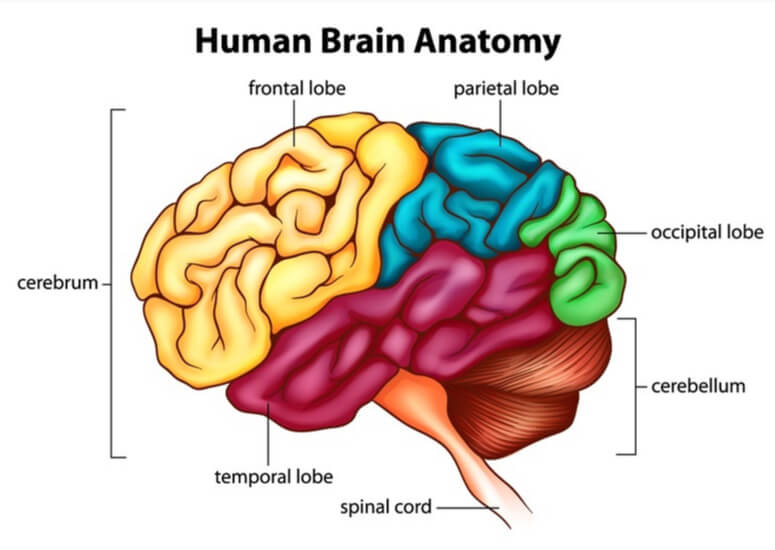
As will be discussed later on in this article, episodic memory uses multiple structures throughout the brain. Primarily, the major structures important to the integrity of episodic memory are found in the cerebrum, specifically in the temporal lobe. However, studies continue to look at alternative regions and less prominent lobes to better determine the full capabilities of episodic memory.
Memory
Memory is defined as the retention of learned information. The concept of memory is possible because neurons have plasticity, where neurons are able to remember and make new connections in the brain. There are two forms of memory: short- term memory and long- term memory. Short- term memory (also known as working memory) only lasts for a short time period in order for people to complete tasks. While it doesn’t necessarily use the same structures as long- term memory, research continues to look into relationships between the two.
Long- term memory is further broken down into declarative vs non-declarative memory (also known as explicit vs. implicit memory). Non-declarative memory includes skills, habits, classical conditionings, and non- associative learning. Specifically, this form of “memory” does not actually require access to stored memory content. It is instead formed by non-conscious abilities that are capable of altering behavior. Meanwhile, declarative memory is the conscious access to facts and events. It is broken down into semantic and episodic memory, where semantic memory is the conscious access to facts and episodic memory is the conscious access to events.
Episodic Memory
Episodic memory is a sub-topic in cognitive psychology regarding the human potential for recalling past personal experiences. It is a form of declarative memory, as is its counterpart- semantic memory. Semantic memory, however, does not require recalling personal experiences. Instead, semantic memory is the ability to remember knowledge and facts that may not need to be personal and can thus be applied across multiple scenarios. Examples such as this can include knowing how many feet are in a mile or knowing what colors make up a flower. Specifically, episodic memory has been nicknamed the human ability to “mentally time travel”, allowing humans to “re-experience” past events. In order for this to happen, the human mind must be self-aware of three things: the ability to recognize its own self, the concept of time, and that the event being recalled has already occurred.

It has been traditionally believed that humans were the only species capable of episodic memory, while other species may be capable of having an episodic- “like” memory. Recently, it has been found that birds and rodent species have the capacity to support episodic memory. This has been speculated by studying the structures known to participate in human episodic memory in other animal species and comparing their sizes and neural potentials.
Associated Brain Structures in Episodic Memory
As a part of the mind, multiple brain structures have been studied in relation to episodic memory. The hippocampus is regarded as the critical structure for its maintenance. However, several areas in the cortex- such as the parahippcampal region and prefrontal cortex- have also been regarded as prominent structures.
Hippocampus
The hippocampus is a brain structure found across multiple species that is found in the inner region of the temporal lobe. It is made up of the subiculum, dentate gyrus, and cornu Ammonis regions. Many connections within the hippocampus come from the entorhinal cortex of the temporal lobe. The hippocampus also connects to the septum of the forebrain, found near the midline of the entire brain. Functionally, the hippocampus is important for maintaining spatial memory.
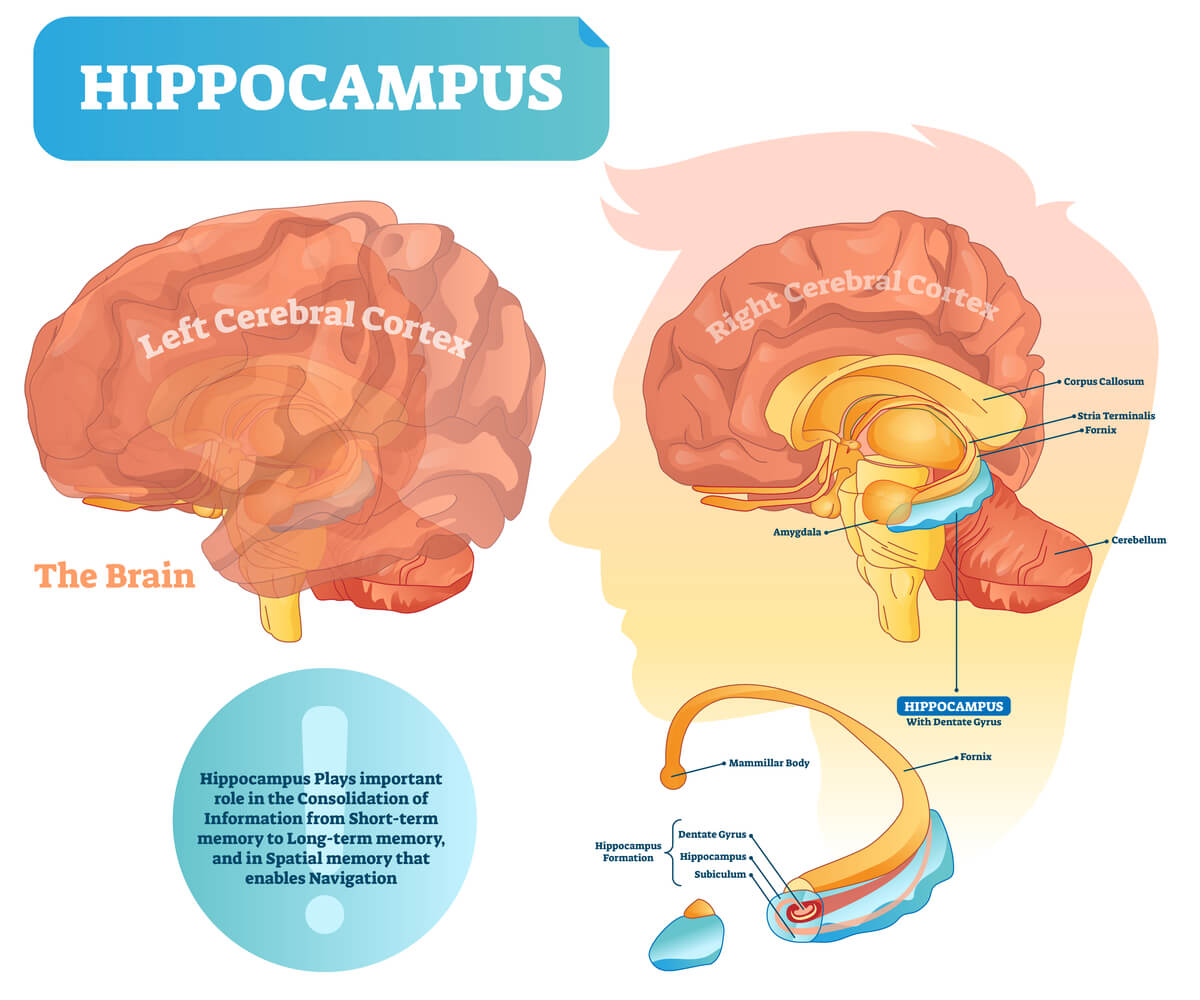
Parahippocampus
The parahippocampus, entorhinal cortex, and perirhinal cortex (all of the temporal lobe) are major regions that interconnect the hippocampus with the surrounding cortex. The parahippocampal region contains two pathways for sending information. These include the “what” pathway and the “where” pathway. The “what” pathway is important for processing features and objects. All of the body’s senses are used in this pathway, allowing for the creation of memories in regard to objects. This pathway consists of the perirhinal cortex and lateral entorhinal cortex.
Meanwhile, the “where” pathway processes visuospatial information, allowing for an individual to remember space and location. As a common pathway conserved in many animal species, this has been evolutionarily important for navigating an individual’s location through an environment. This pathway consists of the parahippocampal/perirhinal cortex and medial entorhinal cortex.
Prefrontal Cortex
The prefrontal cortex receives information from the cortical regions and includes major connections to the cortical and subcortical motor regions. It directly connects to the hippocampus and indirectly connects to the parahippocampal regions. Functionally, the prefrontal cortex assists working memory, inferential reasoning, and decision-making. Due to its connections to the motor cortex, it is suggested that the prefrontal cortex plays a large role in action performance. Therefore, it is further suggested that the prefrontal cortex is responsible for bridging an individual’s perception to previous experiences and then corresponding appropriate actions in response.

Connections Between Structures
Episodic memory begins with sensory processing- through taste, touch, sound, and sight- which are directly relayed to the nuclei of the thalamus (found in the cerebral cortex). This information is brought to primary sensors in the neocortex. Here, the information is separated based on complexity levels and brought to the hippocampus and parahippocampal regions. At the hippocampus, information detailing specific items and stimuli is separated from information detailing contextual information. This is the location at which “what” vs “where” separates in the brain.
As an additional dimension, the brain must also filter information detailing “when”. While this process is less understood, it is critical to know given episodic memory’s role in differentiating past events while being aware of the present self. Currently, it is thought that the cortex and subcortical structures- such as the striatum– play a role in this processing.
Recalling Episodic Memory
Episodic memory is activated when an individual recalls a specific event in context to the present moment. Specifically, this is done by the hippocampus. When the hippocampus activates, the parahippcampal regions and prefrontal cortex can also be activated. The hippocampus is able to directly activate the prefrontal cortex, or it can be indirectly activated by the parahippcampal regions. The prefrontal cortex then largely guides the individual’s actions in response to the memory. Once the prefrontal cortex determines the importance of the recalled memory, it can send signals to the motor complex to initiate an appropriate physical response.
Future Episodic Thought
Research has found many interconnected pathways and overlapping sections relating episodic memory and planning/ predicating the future. This ability is known as future episodic thought and is only known to occur in humans due to our ability to stimulate possible future scenarios. Episodic memory assists these stimulations by determining which outcomes are possible based on past experiences. As a result, the individual can plan accordingly.

Example: A young woman spent a week at the beach in 2018. She made sure to pack enough shorts, t-shirts, and beachwear while expecting the temperature to be steady at 80°F each day. However, she was not aware of the drastic decrease in temperature during nighttime at the beach, and thus did not have any light sweaters packed. When packing for the same beach vacation in 2019, she made sure to include a light sweater and a pair of long pants based on her previous experience.
It is unknown if this ability extends beyond humans into other species, but research is ongoing to test probable hypotheses.
Disorders Involving Episodic Memory
Episodic memory typically declines with age, with cognitive aging defined as the deterioration of higher- order thinking and lowered brain functioning. Given its importance to episodic memory, the hippocampus commonly degrades as individuals become older. Specifically, studies done in rats found that older individuals had the same hippocampal neural firings when placed in both a familiar and new environment. Meanwhile, younger rats experienced changes in firing patterns when placed in the new environment. This suggests that older individuals are less likely to process new environments as separate events, thus interfering with the hippocampus’s ability to recall a specific event when needed.
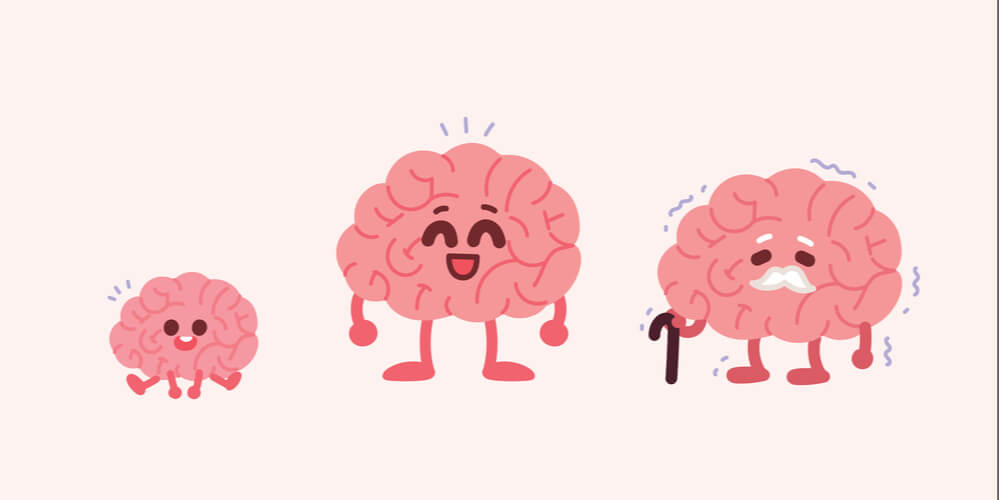
(Note: While episodic memory loss cannot be reversed, exercises can be performed to improve an individual’s current episodic memory!)
As a result of this information, many disorders and diseases that are common in older individuals are more likely to be associated with decreased episodic memory. This is especially evident in diseases where amnesia is the primary symptom present, such as in Alzheimer’s Disease, hippocampal sclerosis, and temporal lobe epilepsy.
Alzheimer’s Disease
Alzheimer’s Disease is the most common neurodegenerative disease, with symptoms ranging from memory loss to dysfunction in decision-making to decreased visuospatial and language capabilities. Scientists are still unsure of how exactly patients come to have the disease. However, it is known that the buildup of amyloid-beta (Aβ) plays a key role in its pathophysiology.
The hippocampus is one of the first structures to degrade in patients with Alzheimer’s Disease. However, those with mild Alzheimer’s quickly increase atrophy of additional structures important for episodic memory. The range in symptoms is further determined by the specific structures and pathways that are degraded.
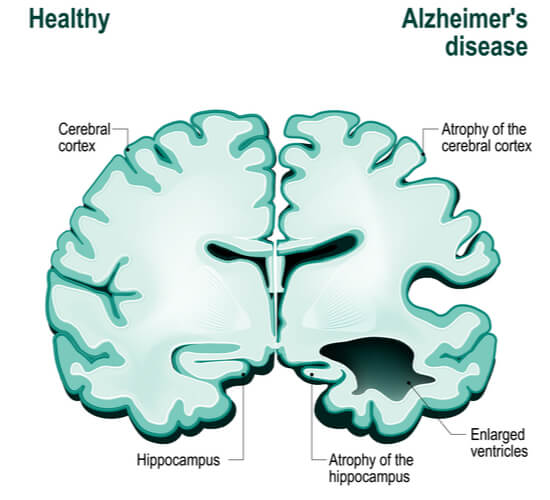
Generally, the main issue concerning memory in Alzheimer’s is the inability to correctly store new information. As a result, patients are unable to “retrieve” those memories when needed. Additional issues arise when patients are unable to recognize the clues itself. Originally, it was believed that the ability to remain “familiar” with an object or event remained intact, while the ability to “recollect” stored information was degraded. However, it is now understood that both familiarity and recollection become dysfunctional in Alzheimer’s patients. This causes patients to lack differentiation between new and old objects and events, thus leading to “false memories”.
It is also interesting to note that different stimuli can project different neural firing patterns in memory storage areas within Alzheimer’s patients. Specifically, pictorial stimuli (such as showing pictures and objects) can lead to better memory recollection than verbal stimuli. This is most likely because people generally remember images better than words representing images.
Hippocampal Sclerosis
Hippocampal sclerosis is another neurodegenerative disease, where (as implied by the name) the hippocampal formation degrades. In comparison to Alzheimer’s Disease, it has been significantly less studied. Similar to Alzheimer’s Disease however, it is more common in elderly patients and with those showing symptoms of dementia. Asymmetric hippocampal and ipsilateral mammillary body degradation is common in hippocampal sclerosis patients, posing as a potentially helpful marker in determining diagnosis. It is also typically present with τ– positive lesions and deterioration of the frontotemporal lobe.
Temporal Lobe Epilepsy
Epilepsy is defined by abnormal electrical activity in the brain, leading to convulsions and loss of consciousness. It is commonly known to include memory impairment, especially in patients with temporal lobe epilepsy. Temporal lobe epilepsy typically occurs in adults and usually includes the hippocampal formation and cortical regions. Interestingly, patients with temporal lobe epilepsy are more likely to have object-specific memory disorders. This is thought to originate following verbal memory impairment. Notably, verbal memory impairment tends to be found in the dominant hemisphere (where speech and mathematical abilities are found). Meanwhile, visual and visuospatial memory impairment is found in the non-dominant hemisphere (where creativity is found).
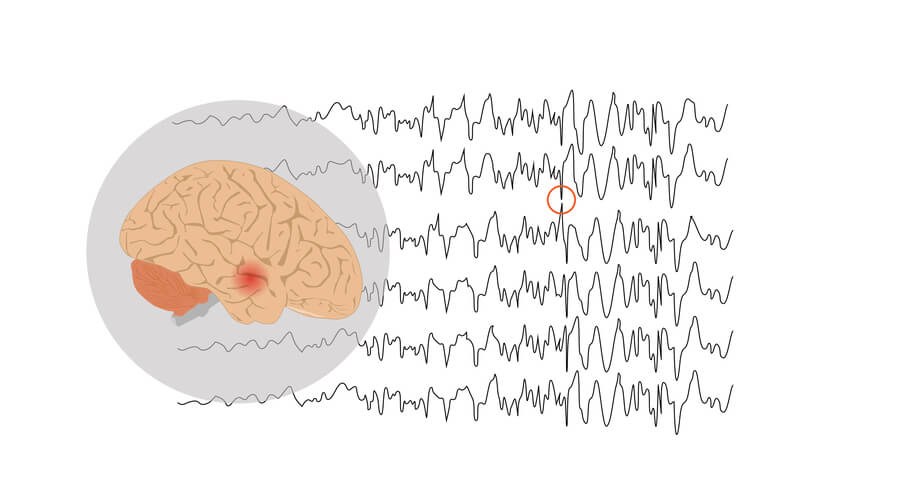
Additional forms of amnesia can be present in patients with epilepsy, including transient epileptic amnesia. This form of amnesia commonly occurs in middle-aged and elderly patients, where the amnesia occurs in short and re-occurring segments. Transient epileptic amnesia can also be present with accelerated long-term forgetting and remote memory impairment. Accelerated long-term forgetting involves the ability to normally learn and remember information in a short time period before rapidly losing this information over the next few days to weeks. Meanwhile, remote memory impairment is the impairment of remote semantic memory compared to recent memories made.
Conclusion
Episodic memory is a form of long-term, declarative memory that allows humans to recall previous personal experiences. Multiple cerebral structures- including the hippocampus, parahippocampus, and prefrontal cortex- are important for retrieving these memories in response to stimuli in the present. They can also activate motor responses as needed. Having episodic memory can allow humans to have future episodic thoughts, where previous personal experiences can allow people to plan for future events. Episodic memory is commonly affected by age, where disorders such as Alzheimer’s Disease, hippocampal sclerosis, and temporal lobe epilepsy can drastically decrease episodic memory potential.
Quiz
